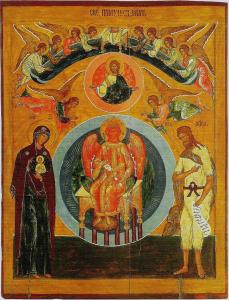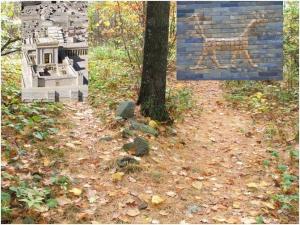 I led a discussion this last Sunday morning focused on Proverbs 8 and 9. These chapters (along with the preceding 1-7) are the key to understanding the focus of the book of Proverbs. The wisdom literature is a crucial, and often misunderstood, part of the Old Testament. Scot has been working through Tremper Longman’s new book The Fear of the Lord Is Wisdom. Chapter 1 of this book along with Longman’s commentary on Proverbs (Baker Commentary on the Old Testament) and his study guide How to Read Proverbs provided the basis for our discussion. (Note – if you buy the Baker Proverbs commentary, try to find a used hard cover edition. The binding on the new paperback edition is horrible.) Quotes below are from the commentary unless otherwise noted. Longman goes over many of the same points in all three books although the commentary has the most detail.
I led a discussion this last Sunday morning focused on Proverbs 8 and 9. These chapters (along with the preceding 1-7) are the key to understanding the focus of the book of Proverbs. The wisdom literature is a crucial, and often misunderstood, part of the Old Testament. Scot has been working through Tremper Longman’s new book The Fear of the Lord Is Wisdom. Chapter 1 of this book along with Longman’s commentary on Proverbs (Baker Commentary on the Old Testament) and his study guide How to Read Proverbs provided the basis for our discussion. (Note – if you buy the Baker Proverbs commentary, try to find a used hard cover edition. The binding on the new paperback edition is horrible.) Quotes below are from the commentary unless otherwise noted. Longman goes over many of the same points in all three books although the commentary has the most detail.
To begin, Longman introduces the concept of implied reader and actual reader. It is important to understand the distinction between the implied reader/hearer and the actual reader of the book of Proverbs. The implied reader or hearer is a young man being instructed by a trusted male adult. On the surface the relationship is father and son, but it may also be teacher and disciple. To understand the illustrations we, as actual readers, must put ourselves in the place of the implied reader/hearer. The book speaks to me as a middle aged American woman … but I gain the most insight when I try to see it from the perspective of a twenty year old ancient Near Eastern male.
Wisdom and Folly are personified in this book as women. The point isn’t that women are wiser (or more foolish) than men, but that wisdom should be made an integral part of life. Choosing the right path matters. As no young man should allow prostitutes and promiscuous women to become integral parts of his life, so too he, and all of the rest of us, should reject Folly and choose Wisdom.
In Chapter 8 we find Wisdom’s autobiography. The chapter can be outlined as follows:
- v. 1-3 Third person introduction – Where to find Wisdom.
- v. 4-11 Preamble of Wisdom’s speech.
- v. 12-21 Introduction to Wisdom’s autobiography.
- v. 22-31 Wisdom’s accomplishments.
- v. 32-36 Wisdom’s advice.
The introduction makes it clear that Wisdom does not hide – she is out in the open calling us to come to her. Longman emphasizes that the rest of this chapter follows the form of ancient Near Eastern autobiographies. In many respects, the most interesting (Longman says tantalizing) part of this chapter is v. 22-31 describing the accomplishments of Woman Wisdom. The following is Longman’s translation p. 203 of his commentary
Yahweh begot me at the beginning of his paths,
before his works of antiquity.
From of old I was formed,
from the beginning, from before the earth.
When there were no deeps, I was brought forth,
when there were no springs, heavy with water.
Before the mountains were settled,
before the hills, I was brought forth.
At that time the earth and the open country were not made,
and the beginning of the clods of the world,
when he established the heavens, I was there,
when he decreed the horizon on the face of the deep,
when he strengthened the clouds above;
when he intensified the fountains of the deep,
when he set for the sea its decree,
wherein the water could not pass where he said
I was beside him as a craftsman.
I was playing daily,
laughing before him all the time.
Laughing with the inhabitants of his earth
and playing with the human race.
Wisdom is described as the firstborn of creation, “She was there before anything else was created and witnessed the creation process itself. Indeed, the implication is not only that she was present but that she also participated in the creation. … The result of her participation is that she had an intimate, joyful relationship both with God and with the human race.” (p. 209 commentary) The language in chapter 8 resembles that used later of Jesus in the New Testament. Woman Wisdom is a personification of God’s wisdom; Jesus is the incarnation of God’s Wisdom. Although it is wrong to see an identity between Jesus and Woman Wisdom, the language helps us understand the nature of Jesus better.
 Which Path? With Woman Wisdom introduced (see also Prov. 1:20-33), It is time to turn to our choice. Proverbs 9 puts it out there.
Which Path? With Woman Wisdom introduced (see also Prov. 1:20-33), It is time to turn to our choice. Proverbs 9 puts it out there.
- v. 1-6 Wisdom’s Invitation.
- v. 7-12 Interlude: Sayings to the counselor.
- v. 13-18 Folly’s invitation.
The interlude has brought some discussion. It seems out of place, but Longman sees it making a point in context. It isn’t worth questioning the place. However, we will skip over this section and consider the two invitations. Proverbs 9, Longman’s Translation (p. 214-215):
Wisdom built her house;
she erected her seven pillars.
She slaughtered her slaughter, mixed her wine.
She also arranged her tables.
She sends her maidens; she issues an invitation
from the pinnacle of the heights of the city:
“Whoever is simpleminded-turn aside here,”
she says to those who lack heart.
“Come, eat my food,
and drink the wine I mixed.
Abandon simplemindedness and live.
March on the path of understanding.”
…
Woman Folly is boisterous ;
she is simpleminded but does not even know it.
She sits at the doorway of her house,
on a seat at the heights of the city.
She invites those who pass by on the path,
those going straight on their way.
“Whoever is simpleminded-turn aside here,”
she says to those who lack heart.
“Stolen water is sweet;
food eaten in secret is pleasant.”
But they do not know that the departed are there,
that those invited by her are in the depths of Sheol.
Simpleminded here is a way of specifying that the implied hearer is young, naive, inexperienced – but capable of choosing the correct path. Both Wisdom and Folly invite the young person into intimate relationship – ask to become an integral part of his life. In the ancient Near East an invitation to dine was not a neutral or superficial invitation, it was an invitation into relationship. This is true of interactions between men and between women, but even more so when the interaction is between a man and a woman. Both Wisdom and Folly call to the simpleminded from the “heights of the city.” Longman points out that the “heights of the city” denotes the location of the Temple throughout the ancient Near East.
Who is Wisdom, Wisdom is clearly a personification of Yahweh’s attribute of wisdom. … But we should also pay attention to the detail that Wisdom’s house is built on the highest point of the city. In the ancient Near East, only one house is built on the high place of a city, and that is the temple. It is not a stretch, therefore, to suggest that Wisdom is not only the personification of Yahweh’s wisdom, but also of Yahweh himself.
If Wisdom is Yahweh, then who is Folly, who also has a house on the high point of the city? It is only consistent to start by saying that she is the personification of foolish thought and behavior, but more. She too represents deity, but in her case she stands for all the pagan gods and goddesses who desire to lure Israel away from the true God. She stands for Marduk, Baal, Ishtar, Anat, Asherah, Chemosh, Molech – and the list can go on and on.(p. 222)
We are called to choose between Wisdom and Folly. There is no middle ground between the choice to follow the ways of God or to follow the ways of idolatry. We are either wise or foolish. There is a fascinating lecture by Longman, given as he was working on The Fear of the Lord and available on vimeo (even for download).
The lecture covers Proverbs, Ecclesiastes, Job, and Song of Songs in 60 minutes (then questions). From 15:00 to 21:02 (only six minutes) he introduces the choice between Woman Wisdom and Woman Folly in Proverbs 9. Later, around 52:30-56:40 he applies this to our reading of the New Testament, our understanding of Jesus, and our lives today. In particular, after identifying echoes and allusions connecting Jesus and Wisdom in the New Testament (in particular, but not limited to Matt. 11:18-19, Col. 1:15-17, John 1:1-3,10), he continues:
This doesn’t mean that Proverbs 8 and 9 are prophecies of Jesus. It’s an association. But it helps us see that when we read Proverbs 9 we can see that it is Jesus who is inviting us to a deeper relationship. And when we think of Woman Folly we don’t think of Baal or Marduk or Asherah, these ancient Near Eastern idols. We think of anything else that might lead us astray and that we would treat as most important in our life, whether it is money, wisdom, work, and that takes us to the book of Ecclesiastes, which is an idol buster. (55:14-55:58)
The choice the reader, both implied and actual, is called to make will shape the rest of life. It should also shape the reading of the rest of the book of Proverbs. This isn’t a collection of secular truisms and sayings. According to Longman: “In this way, the proverbs have theological significance even when they do not explicitly name Yahweh or some well-known theological concept. Wisdom and folly themselves are such theological concepts.” (p. 223)
I have come to regard the Wisdom literature of the Old Testament as some of the most significant parts of Scripture. Here we are exploring important concepts and being trained to think (for the one who makes the effort) in the ways of God and of God’s wisdom.
What are the idols of our culture?
How do we choose the right path?
If you wish to contact me directly, you may do so at rjs4mail[at]att.net
If interested you can subscribe to a full text feed of my posts at Musings on Science and Theology.











